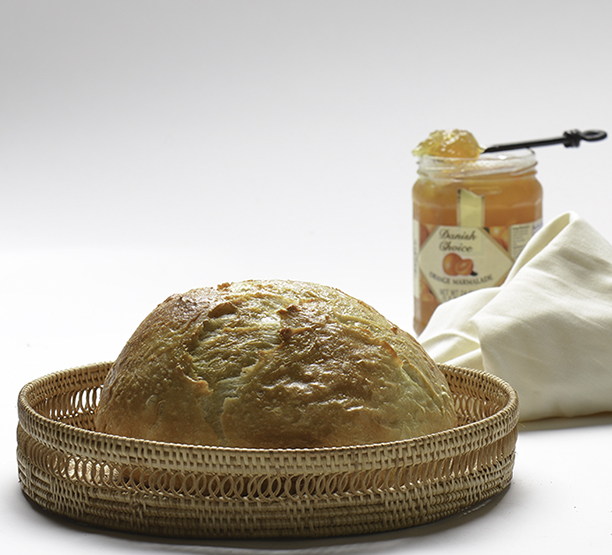Trust me. You can do this.
I know. I know. It’s (eek!) bread making. Still.
This recipe is a “take” on the slow-rise fermentation bread making technique that was popularized some years ago by Jim Lahey, founder of New York’s Sullivan Street Bakery. Mark Bittman, long-time New York Times food columnist, rhapsodized about the technique: “This loaf is incredible, a fine-bakery quality European style boule that is produced more easily than by any other technique I’ve used, and it will blow your mind.” Here is a link to the lengthy original story that Bittman wrote about Lahey’s bread. If you love cooking, the article is an excellent read: NY Times: Mark Bittman on Jim Lahey and His No-Knead Bread.
Lahey wrote a book, My Bread, about the process and it is still in print. (Jim Lahey’s My Bread Available on Amazon)
In that book, Lahey confesses that he first made bread during his college days at Stony Brook to impress a girl. An aspiring painter and sculptor, he wanted to be “unforgettably impressive” and could think of no loving gift more impressive than a loaf of bread made with his own hands. The object of his affection was a little taken aback by the gift, he wrote, thinking he was probably a little nuts, but the experience convinced him that bread making was a worthy life-long pursuit. Of that epiphany he wrote: “Baking had other rewards beyond the psychological and cerebral: I loved getting messy, flour flying dough sticking to my hands and clothes. I reveled in the tactile joy of baking bread–so much of which was like working with clay. When it was all over, I was thrilled that not only could my creation be appreciated as an object, the way sculpture is, but that it would be consumed, internalized by someone I cared about.”
(PM me if you know where to find a man like that.)
Using this adaptation of Lahey’s technique, this bread is a cinch to make. It takes about five minutes to make the dough. Then you walk away. The bread needs to rise and develop its texture and flavor for at least eight hours, making it a natural to make at night to bake the next day. The bread then gets a shaping and a slow rise before you bake it in your Dutch oven at a high heat.
Try this great recipe. It will blow your mind.
Ingredients
- 3 C. all-purpose flour
- 2 t. kosher salt
- 1/2 t. active dry yeast
- 1 1/4 to 1 1/2 C. lukewarm water
Instructions
- Stir flour, salt and yeast together in a large bowl. Using a wooden spoon, stir in the water until your dough begins to come together into a cohesive shaggy mass. Be careful not to overwork your dough and use only as much water as you need to bring the dough together. The less you handle it, the more air you will leave in the dough and the more air pockets you will have in your finished bread.
- Place the ball of dough in a lightly-greased bowl and cover the bowl tightly with Saran Wrap. Let the dough sit out on your counter for 8-12 hours.
- When you are ready to bake your bread, preheat your oven to 450 degrees F. Put a Dutch oven (without the lid) into your preheated oven and let it heat up for 30 minutes.
- Meanwhile, turn your dough out onto a floured surface and form it into a ball. Cover it loosely with
- Saran Wrap and let it rest while your Dutch oven heats.
- After your Dutch oven has heated in the oven for 30 minutes, carefully remove it from the oven and, with floured hands, place your dough it it. (I put my dough on a piece of parchment and put it into the Dutch oven on the parchment. This helped insulate the bottom of the bread and kept it from burning during baking. I also sat my Dutch oven on a cookie tray in the heated oven to further insulate the Dutch oven and the bread.)
- Put the cover on the pan and bake for 30 minutes. Remove the cover and brush the top of the bread with egg wash (an egg beaten with a tablespoon or two of water) and bake for 15 to 20 minutes more to brown the top of the bread.
- Remove the bread from the oven and let it cool on a rack before cutting.

 Save Recipe
Save Recipe
